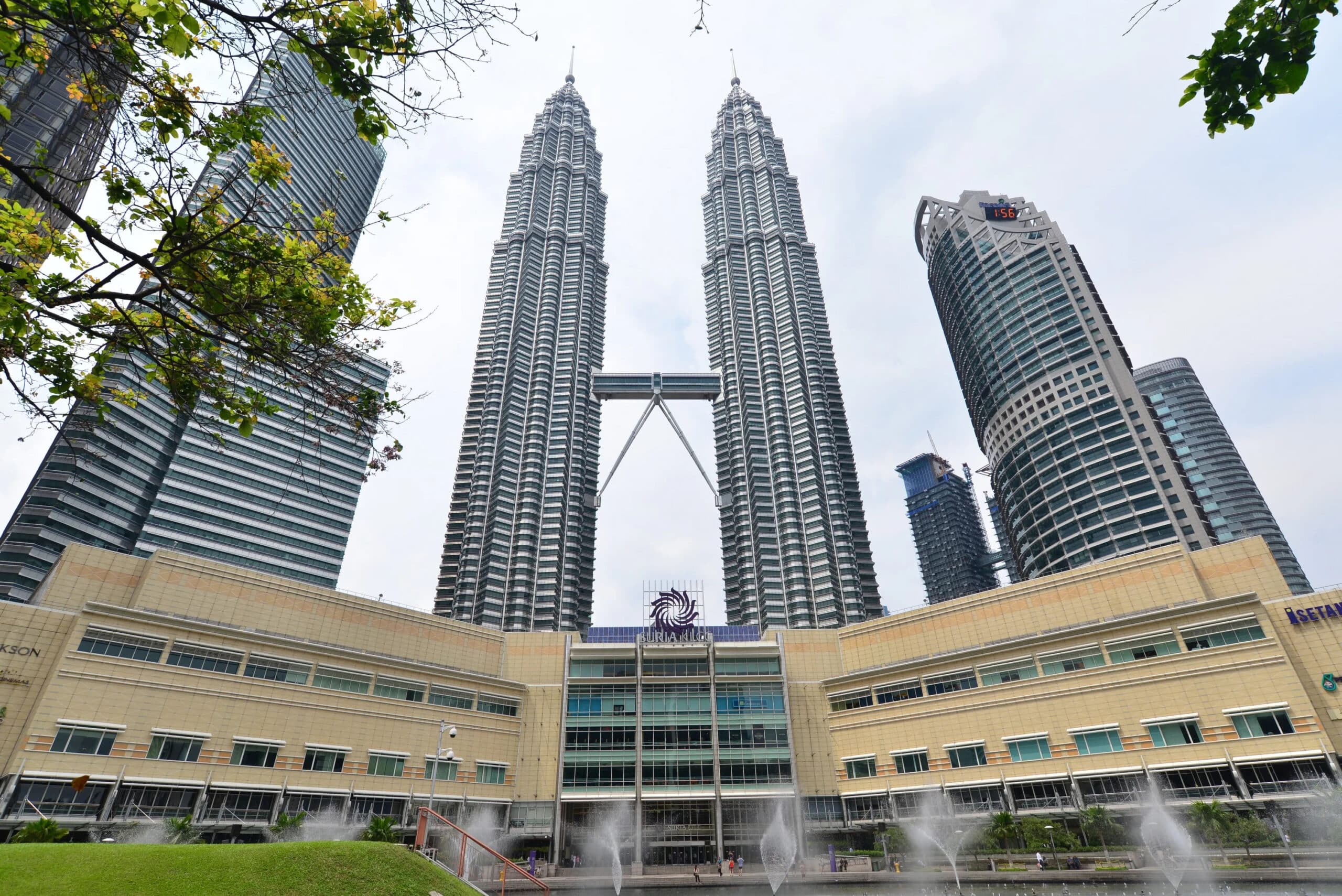
The Petronas Twin Towers, standing majestically in the heart of Kuala Lumpur, Malaysia, are not merely architectural marvels but towering symbols of the nation’s economic prowess and modernization. Designed by the renowned Argentine architect César Pelli, these iconic structures have etched themselves into the global skyline, captivating the world with their impressive height, intricate design, and symbolic significance. From their groundbreaking construction period starting in 1993 to their completion in 1999, the Petronas Twin Towers have become more than just a corporate hub; they embody the spirit of Malaysia’s progress and serve as a beacon of pride for the nation. Let’s delve into 25 fascinating historical facts and numerical trivia that illuminate the story behind these twin giants, exploring their construction, design, and the impact they’ve had on Malaysia’s landscape and international recognition.
Construction Period: The construction of the Petronas Twin Towers marked a significant undertaking that began on March 1, 1993, and concluded on August 28, 1999. This six-year period was characterized by meticulous planning, groundbreaking engineering solutions, and the coordination of a vast workforce. The towers’ development was part of Malaysia’s ambitious vision for economic growth and urban development in Kuala Lumpur, positioning them as a symbol of the nation’s progress.
Height: Soaring into the skyline at a height of 451.9 meters (1,483 feet), the Petronas Twin Towers held the coveted title of the world’s tallest twin towers until 2004. The towers’ remarkable height was achieved through a combination of cutting-edge construction techniques, including a high-strength reinforced concrete core and a sleek external facade of stainless steel and glass. This elevation not only served practical purposes for the tenants but also contributed to the towers’ symbolic significance, representing Malaysia’s emergence on the global stage.
Architectural Design: The visionary mind behind the Petronas Twin Towers was César Pelli, an esteemed Argentine architect and his team at Pelli Clarke Pelli Architects. Pelli’s design seamlessly blends modern aesthetics with Islamic-inspired motifs, reflecting Malaysia’s cultural identity. The towers feature an innovative double-decker skybridge and a faceted facade, adding a unique touch to Kuala Lumpur’s skyline and showcasing Pelli’s mastery in creating iconic structures.
Cost of Construction: The Petronas Twin Towers came with a hefty price tag, as their construction cost amounted to approximately $1.6 billion USD. This substantial investment underscores the commitment of the Malaysian government and Petronas in creating a monumental landmark that not only serves as a corporate hub but also as a symbol of national pride and progress.
Number of Floors: Each tower boasts an impressive 88 floors, along with an additional 5 basement levels, making a grand total of 93 levels. This extensive vertical expanse accommodates a diverse range of tenants, including multinational corporations and retail establishments, contributing to the towers’ status as a dynamic hub for business and commerce.
Materials Used: The construction of the Petronas Twin Towers involved a careful selection of materials to ensure both structural integrity and aesthetic appeal. Reinforced concrete forms the backbone of the towers, providing robust support, while the exterior features a striking combination of stainless steel and glass curtain walls. This fusion of materials not only contributes to the towers’ iconic appearance but also underscores their durability and resilience.
Skybridge: One of the most iconic features of the Petronas Twin Towers is the double-decker skybridge that elegantly links the two towers at levels 41 and 42. This architectural marvel, spanning a length of 58.4 meters (192 feet), stands as the highest two-story bridge globally. Serving both as a functional element to facilitate inter-floor connectivity and a symbol of unity, the skybridge exemplifies the towers’ innovative design and engineering.
Bridge Length: The skybridge, a focal point of the towers’ design, extends gracefully between the towers for a length of 58.4 meters and weighs an impressive 750 tons. Crafted with precision and utilizing advanced construction techniques, the skybridge not only provides breathtaking panoramic views of the city but also stands as a testament to the engineers’ ingenuity in creating a structure that seamlessly connects two towering landmarks.
Tower Topping Ceremony: A pivotal moment in the towers’ construction occurred on March 1, 1996, with the Tower Topping Ceremony. This traditional construction milestone celebrated the completion of the towers’ structural framework, symbolizing the culmination of years of planning and construction efforts. The event marked a significant achievement for the entire project team, reflecting the successful realization of a groundbreaking architectural vision.
Lightning Rods: At the summits of the Petronas Twin Towers, sophisticated lightning rods are strategically placed to safeguard the structures from the frequent tropical thunderstorms of the region. These lightning rods, along with other advanced safety features, exemplify the meticulous attention to detail and the commitment to ensuring the towers’ structural resilience and long-term durability.
Facade: The exterior facade of the Petronas Twin Towers is a stunning marriage of form and function. Comprising stainless steel and glass curtain walls, this design not only imparts a sleek and modern appearance but also serves practical purposes such as insulation and weather resistance. The facade’s intricate detailing reflects the influence of Islamic art, adding cultural richness to the towers’ aesthetic appeal. With 32,000 windows, the towers’ facade is a testament to the fusion of architectural elegance and practicality.
Floor Area: Each of the Petronas Twin Towers offers a vast interior space, totaling approximately 395,000 square meters. This extensive floor area accommodates a diverse range of occupants, including corporate offices, retail outlets, and other facilities. The meticulous planning and utilization of space contribute to the towers’ efficiency as a multifunctional complex, fostering a vibrant environment for business and commercial activities.
Elevators: Vertical transportation within the towers is facilitated by 29 double-deck high-speed passenger elevators in each tower. These elevators, equipped with advanced technology, ensure swift and efficient travel between the numerous floors. The elevator system represents a crucial aspect of the towers’ functionality, meeting the demands of a high-rise structure and enhancing the overall user experience for occupants and visitors alike.
Windows: The Petronas Twin Towers boast an impressive 32,000 windows, contributing to the towers’ distinctive appearance and providing abundant natural light to the interior spaces. The design and placement of these windows were carefully considered not only for aesthetic purposes but also to optimize energy efficiency and create a comfortable working environment for the occupants. The sheer scale of the window installation reflects a commitment to architectural excellence and user well-being.
Tenant Mix: The towers are home to a diverse mix of tenants, including multinational corporations, financial institutions, and retail establishments. This blend of occupants contributes to the dynamic atmosphere within the towers, fostering collaboration and interaction among different sectors. The towers, therefore, serve as a bustling hub of economic activity and corporate synergy, reflecting their significance in Kuala Lumpur’s business landscape.
Funding: The Petronas Twin Towers project was funded by a collaboration between the Malaysian government and Petronas, the national oil company. This joint financial commitment highlights the towers’ strategic importance as a symbol of economic prosperity and corporate prestige. The funding model underscores the public-private partnership that drove the development of this architectural masterpiece.
National Symbolism: Beyond their practical purposes, the Petronas Twin Towers hold immense symbolism for Malaysia. As a prominent feature of the Kuala Lumpur skyline, the towers represent the nation’s economic prowess and modernization. Their status as a national symbol is further emphasized by their association with Petronas, a key player in the Malaysian economy, making the towers a source of pride for the country and its people.
Facade Lighting: The towers’ exterior lighting system is a masterpiece in itself, showcasing a sophisticated play of lights during the night. This illumination not only enhances the towers’ visual appeal but also serves as a symbolic representation of Kuala Lumpur’s vibrant and cosmopolitan identity. The dynamic facade lighting has become an iconic feature, drawing admiration from both locals and tourists and contributing to the towers’ recognition as a global architectural landmark.
Tourism: The Petronas Twin Towers have become a major tourist attraction, drawing millions of visitors annually. The towers offer an observation deck on the 86th floor, providing breathtaking panoramic views of Kuala Lumpur. The inclusion of a skybridge tour further enriches the visitor experience, allowing them to witness the architectural marvel up close and learn about the towers’ construction, history, and significance in the context of Malaysia’s development.
Construction Workforce: The construction of the Petronas Twin Towers required a massive workforce, with over 7,000 workers at its peak. This diverse and skilled labor force contributed to the towers’ successful realization, working collaboratively to overcome engineering challenges and meet strict construction timelines. The significant number of workers reflects the scale and complexity of the project, highlighting the collective effort that went into bringing the towers to life.
Awards: The Petronas Twin Towers have garnered numerous prestigious awards, recognizing their architectural and engineering excellence. These accolades include the Aga Khan Award for Architecture, the Council on Tall Buildings and Urban Habitat (CTBUH) Best Tall Building Award, and the Malaysian Institute of Architects Gold Medal. These honors underscore the global recognition of the towers as a groundbreaking architectural achievement, showcasing their lasting impact on the field.
Wind Speed Resistance: Designed to withstand wind speeds of up to 70 miles per hour, the Petronas Twin Towers showcase a commitment to structural resilience. The towers’ robust design, including their reinforced concrete core and sleek profile, minimizes wind resistance and ensures stability during adverse weather conditions. This engineering feat ensures the safety and longevity of the towers in the face of Malaysia’s tropical climate.
Foundation: The foundation of each tower is a critical element in their structural integrity, consisting of 104 concrete bore piles, each reaching a depth of 60 meters. This extensive foundation provides a solid base for the towers, distributing the immense weight evenly and ensuring stability against various geological conditions. The engineering precision involved in laying the foundation contributes to the towers’ ability to withstand both natural forces and the test of time.
Maintenance: Regular maintenance is essential to preserve the Petronas Twin Towers’ pristine appearance and structural integrity. The towers undergo periodic painting and cleaning to combat the effects of weathering and environmental factors. The maintenance efforts, which include inspection of the facade and structural elements, demonstrate a commitment to upholding the towers’ aesthetic appeal and ensuring their long-term durability.
Iconic Film Appearance: The Petronas Twin Towers achieved global recognition through their appearance in the 1999 film “Entrapment,” starring Sean Connery and Catherine Zeta-Jones. The towers played a central role in one of the film’s memorable scenes, where the characters engage in a daring heist by navigating the exterior of the towers. This cinematic exposure further elevated the international profile of the Petronas Twin Towers, cementing their status as not only architectural wonders but also cultural icons.








